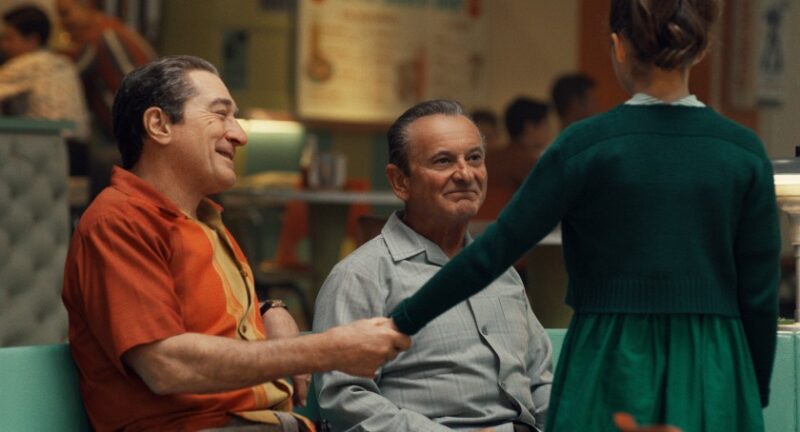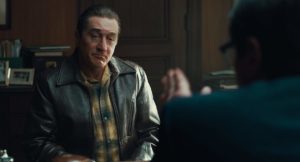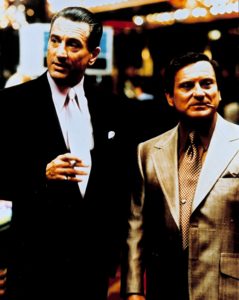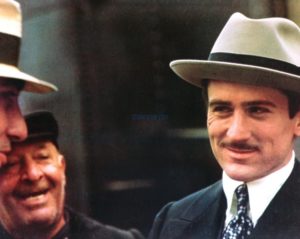
Acting legend enhances lengthy Mob movie resume with ‘The Irishman’
Robert De Niro best known for playing iconic underworld characters

Screen legend Robert De Niro, with a long list of classic Mob movies to his credit, has a lead role in another major Mafia film this fall, The Irishman, about the killing of labor leader Jimmy Hoffa.
The movie by director Martin Scorsese, a longtime collaborator with fellow Academy Award-winner De Niro, debuted at the New York Film Festival in September. The Irishman is showing in a select number of theaters in November to qualify it for Oscar nominations before streaming on Netflix beginning November 27. Theater locations and ticket information are on the movie’s website, theirishman-movie.com.
Based on the 2004 book I Heard You Paint Houses by former prosecutor Charles Brandt, the film features De Niro as Frank “The Irishman” Sheeran, a World War II combat soldier and Mafia hit man who claims to have killed his friend Hoffa on orders from the Mob. “Painting houses” is code for contract killing.

On July 30, 1975, Hoffa, a former Teamsters Union president who had served time in prison for pension fraud and jury tampering and was hoping to regain control of the national union, disappeared from the parking lot of a suburban Detroit restaurant, where he supposedly was to meet with Mafia leaders to resolve differences. Since then, no one has been held criminally responsible for the 62-year-old Hoffa’s death, and his body has never been found, though a judge later declared him legally dead.
Some authors contend Sheeran did not kill Hoffa, pointing to other mobsters as the shooter, including ones from New Jersey and Detroit. While this debate continues, the three-and-a-half-hour movie is receiving positive reviews and reviving interest in Hoffa and that era in Mafia history.
A much-discussed de-aging component in the film also is receiving attention. This technology gives the actors a younger look when they play the earlier versions of their characters. In addition to De Niro, the movie features veteran stars Al Pacino as Hoffa and Joe Pesci as Mafia boss Russell Bufalino.
As the title character in the The Irishman, playing the gunman who takes out Hoffa, De Niro’s role is central to the story — and is one more in the 76-year-old actor’s list of important performances in Mob movies. Some of these roles have been in comedic Mob films, such as 1971’s The Gang That Couldn’t Shoot Straight and the more recent Analyze This and Analyze That. But De Niro also put a more profound stamp on pictures in this category with serious roles in The Godfather: Part II, Casino, Goodfellas and more. His directorial debut, A Bronx Tale, in 1993, also features him in a starring role as a hard-working father who drives a public bus for a living while trying to keep his son from falling in with the street-corner Mafioso in their New York neighborhood. The movie is dedicated to his father, a painter, who died in 1993.
With these iconic movies, De Niro, a New York native famous for his intense study of the characters he portrays, has carved out a reputation as one of the best at playing inhabitants of the criminal underworld.

Ronald Fino, the son of a ranking mobster, said he considers De Niro’s portrayals of the people in this “arcane brotherhood” to be accurate. Fino, an official with a Mob-connected labor union in Buffalo before becoming a consultant for the FBI and CIA, is the subject of an upcoming documentary, Mr. Undercover.
“I like Pesci in Goodfellas, flashing moments of Bogart and Robinson,” Fino said in a Facebook message, “but pound for pound I believe that Robert De Niro was and is the best.”
As noted in the nonfiction book Best of Enemies, De Niro and Fino were among those called on to use their influence in helping to free a Russian spy, Gennady Vasilenko, from harsh prisons in his own country. The 2018 book by Gus Russo and Eric Dezenhall looks at the friendship between Vasilenko and a U.S. spy — and the suspicions that this bond arouses. In the end, after international negotiations, Vasilenko was released.
Over the years, Fino’s firsthand knowledge of organized crime networks has put him in contact with Mob figures in places such as Russia and the United States. One of those he knew was Frank “Lefty” Rosenthal, who, operating out of the Stardust hotel-casino on the Las Vegas Strip, oversaw the illegal skimming of gambling revenue for crime families in the Midwest.
In Casino, De Niro plays a character based on Rosenthal, with Sharon Stone as his wife and Pesci as a volatile mobster patterned after Tony Spilotro, the Chicago Outfit’s enforcer in Las Vegas during the 1970s and ’80s. (Spilotro and his brother Michael were beaten to death in 1986 at a home near Chicago’s O’Hare International Airport and buried in an Indiana cornfield.) The film was adapted from the 1995 nonfiction book Casino: Love and Honor In Las Vegas by New York writer Nicholas Pileggi, focusing in part on Frank and Geri Rosenthal’s troubled marriage and her romance with Spilotro.
In Fino’s view, De Niro’s portrayal of the Rosenthal character is perfect. “De Niro nails it,” Fino said.
The movie’s significance was underscored during a conversation involving De Niro, Scorsese and comedian Don Rickles in a “Dinner With Don” web interview that Rickles hosted for AARP Studios. The dinner conversation with De Niro and Scorsese was recorded on January 27, 2017, at Craig’s Restaurant in West Hollywood only months before Rickles died at age 90. This was Rickles’ final professional performance.

During dinner, the three reminisce about the entertainment industry in general and about the early days in Las Vegas, dating to the 1950s, when Rickles first began performing there, including at the now-demolished Stardust. Rickles speaks fondly of the “wiseguys” who were in Las Vegas then and says they treated performers with class. “It was really great to know those guys,” he says.
At one point, Scorsese says he wanted Rickles to play the right-hand man of De Niro’s character in Casino because Rickles had known Rosenthal and was someone with “the look, the atmosphere, all the sense of Vegas.”
This 10-minute video is conversational and playful, and it shows the affection and respect these three have for one another.
For De Niro and Scorsese, this mutual respect is the result of a long working relationship, which includes general crime titles such as Taxi Driver and Cape Fear, and continues with The Irishman — their first Mob movie together since Casino 24 years ago. And the collaboration apparently doesn’t end there. The two are reported to be working on a film based on the 2017 book Killers of the Flower Moon: The Osage Murders and the Birth of the FBI by David Grann, a New Yorker magazine staff writer.
Looking at the great actor-director collaborations in film history, authors George Anastasia and Glen Macnow in 2011’s The Ultimate Book of Gangster Movies mention some of the memorable pairings: John Wayne and John Ford; Humphrey Bogart and John Huston; Jack Lemmon and Billy Wilder.
In reviewing the movie Casino, at that time the eighth collaboration between De Niro and Scorsese, the authors name their choice as the greatest paring of all: Robert De Niro and Martin Scorsese.
De Niro’s Mob movie list
Robert De Niro has starred in a number of crime films and thrillers, but these are the ones dealing at least in part with the Mob: The Gang That Couldn’t Shoot Straight (1971), Mean Streets (1973), The Godfather: Part II (1974), Raging Bull (1980) Once Upon a Time in America (1984), The Untouchables (1987), Midnight Run (1988), Goodfellas (1990), A Bronx Tale (1993), Mad Dog and Glory (1993), Casino (1995), Cop Land (1997), Analyze This (1999), Analyze That (2002), The Family (2013), The Irishman (2109)
Larry Henry is a veteran print and broadcast journalist. He served as press secretary for Nevada Governor Bob Miller, and was political editor at the Las Vegas Sun and managing editor at KFSM-TV, the CBS affiliate in Northwest Arkansas. Henry taught journalism at Haas Hall Academy in Bentonville, Arkansas, and now is the headmaster at the school’s campus in Rogers, Arkansas. The Mob in Pop Culture blog appears monthly.
Feedback or questions? Email blog@themobmuseum.org





